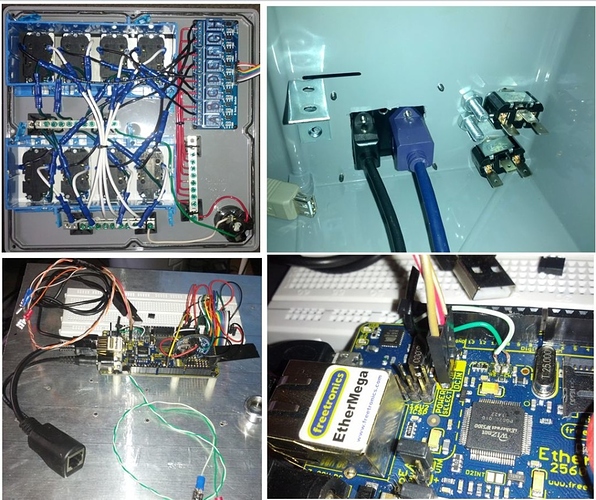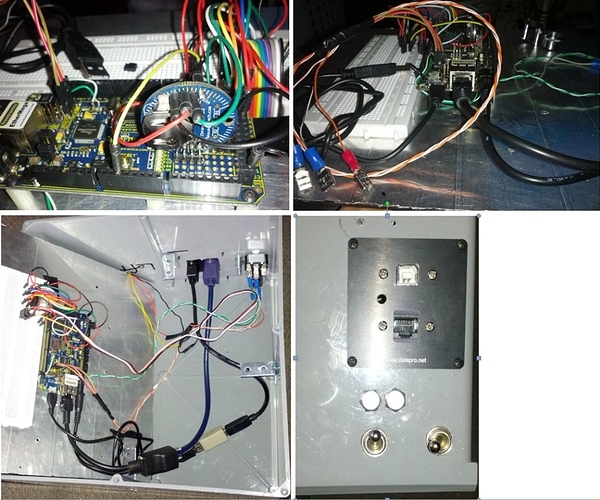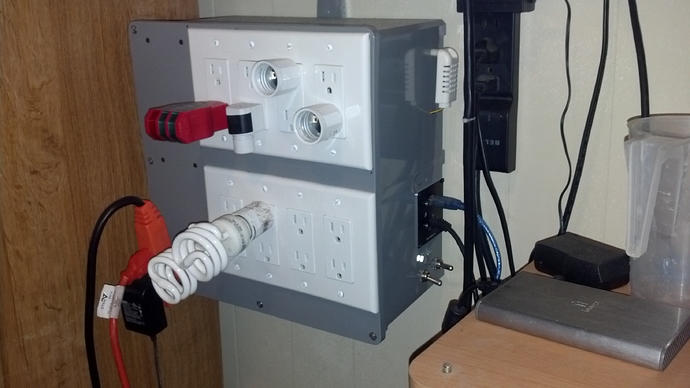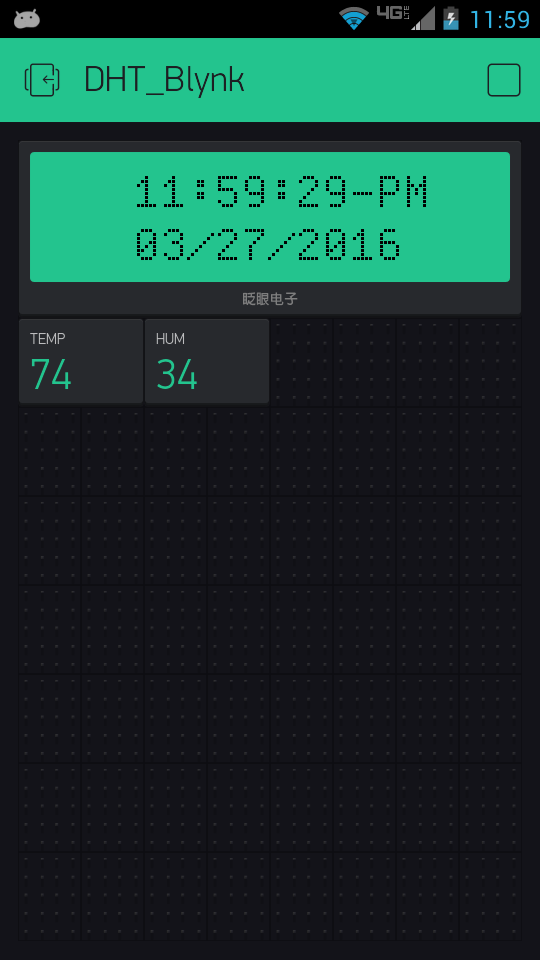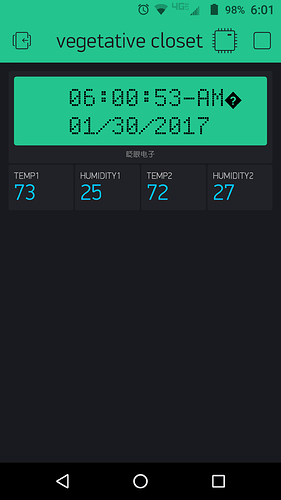My project has been in the making for just over a year now, and once I got it as far as I could (pre-Blynk), I hit a brick wall as I wanted so much for this project to be accessible over the web, the current options available were not what I was looking for, until I found Blynk!
Alas, I now have Blynk and have received ample help from the Blynk community to work out all the bugs that were in my code. I slimmed my sketch down so that it deals only with the data collection and conversions, and now my app has but 3 Widgets to receive all that data.
From Home Depot, I purchased a water tight utility box and morphed it into a project box to house my project. On its face is an American style male plug for AC voltage in. I also have 8 duplex AC outlets, each connected to a single channel of my 8 channel Sainsmart relay. As this is a hydroponics controller/greenhouse controller, AC devices can be power cycled in accordance with time kept on the in circuit DS3231 Chronodot RTC, or according to threshold values set against the DHT22 temp/humidity sensor readings.
My MCU is a Freetronics EtherMega (Arduino Mega and Ethernet shield combined). The RTC is an I2C device, and the DHT22 is connected to D13. I also went ahead and cut the RESET-EN trace and soldered some cat5 wire to the pads, and connected the other ends to terminal on a switch so that I can enable or disable this feature of Arduino. When using the serial monitor, the time kept on the RTC would otherwise reset and lose the current time. I also have another switch wired to the EtherMega’s power select header to switch between USB power and DC power. The DC power supply is fed via a Passive POE injector as shown in the pictures. This way, I can locate the project wherever, without needing to be near an AC outlet, plus it looks much cleaner.
I will add the pics, I took some months back, then post the slimmed down version of the code. In another code window, I will also post the other portions of the code that runs the program aside from what Blynk sees. I can later add 8 button widgets to also trigger relays in real time if I ever have need of overriding the programmed times. This is a work in progress and will definitely be getting updated as I accumulate more equipment in need of control, but at this moment, the project can be a stand alone room controller for an indoor garden or greenhouse.
#include <SPI.h>
#include <Ethernet.h>
#include <BlynkSimpleEthernet.h>
#include <Wire.h>
#include "DHT.h" // DHT data wire connected to D13 with a 10k pullup resistor
#include <SimpleTimer.h>
#include "RTClib.h" // RealTimeClock Library for DS1307 and DS3231
#define BLYNK_PRINT Serial
#include <SPI.h>
//*******Sensor Model********************************
#define DHTTYPE DHT22
#define DHTPIN 13
RTC_DS1307 RTC;
float UTCOffset = -5.0; // Your timezone relative to UTC (http://en.wikipedia.org/wiki/UTC_offset)
char auth[] = "YourAuthKey";
DHT dht(DHTPIN, DHTTYPE);
byte h;
byte f;
SimpleTimer timer;
WidgetLCD lcdA(V2); //Set LCD widget Input to PUSH
void setup()
{
Serial.begin(9600);
//Serial2.begin() // For other baud rates
//Serial3.begin() // For other baud rates
Blynk.begin(auth);
pinMode(DHTPIN, OUTPUT);
dht.begin();
RTC.adjust(DateTime(__DATE__, __TIME__));
RTC.begin();
while (Blynk.connect() == false) {}
timer.setInterval(5000L, climateCheck); // 5 second intervals between DHT readings
timer.setInterval(3000L, RTCdisplay); // 3 second intervals between RTC readings
}
void loop()
{
Blynk.run();
timer.run();
}
void climateCheck()
{
h = dht.readHumidity();
f = dht.readTemperature(true);
Blynk.virtualWrite(V0, f); // Set Virtual Pin 0 frequency to PUSH in Blynk app
Blynk.virtualWrite(V1, h); // Set Virtual Pin 1 frequency to PUSH in Blynk app
//Serial.print(f);
//Serial.print(h);
}
void RTCdisplay()
{
DateTime now = RTC.now(); // reads time at beginning of loop
byte twelveHour = now.hour() - 12; // Variable used to display 13+ hours in 12 hour format
byte zeroHour = 12; // Variable use to convert "0" zero hour to display it as 12:00+
byte displayHour;
byte MIN = now.minute();
byte SEC = now.second();
char* meridian;
if (now.hour() == 0) // First we test if the hour reads "0"
{
displayHour = zeroHour;
meridian = "AM";
}
else if (now.hour() >= 13) // if no, Second we test if the hour reads "13 or more"
{
displayHour = twelveHour;
meridian = "PM";
}
else
{
displayHour = now.hour();
meridian = "AM";
}
char timeStamp[11];
char dateStamp[11];
sprintf(timeStamp, "%02d:%02d:%02d-%02s", displayHour, MIN, SEC, meridian);
sprintf(dateStamp, "%02d/%02d/%04d", now.month(), now.day(), now.year());
String ts;
String ds;
ts = timeStamp;
ds = dateStamp;
lcdA.clear(); //Advanced Mode
lcdA.print(3, 0, ts); //Advanced Mode
lcdA.print(3, 1, ds); //Advanced Mode
}
and the redacted out code. Use good judgment when adding the following snippets back into the sketch.
#define TURN_ON 0 // TURN_ON and TURN_OFF are defined to account for Active High relays
#define TURN_OFF 1 // Used to switch relay states for on/off of AC devices
#define Relay_A 30 // relay 1 - Mega Pin 30 // Lights
#define Relay_B 31 // relay 2 - Mega Pin 31 // Feed Pump(s)
#define Relay_C 32 // relay 3 - Mega Pin 32 // ------------
#define Relay_D 33 // relay 4 - Mega Pin 33 // ------------
#define Relay_E 34 // relay 5 - Mega Pin 34 // Exhaust Fan
#define Relay_F 35 // relay 6 - Mega Pin 35 // Heater
#define Relay_G 37 // relay 7 - Mega Pin 36 // Dehumidifier
#define Relay_H 36 // relay 8 - Mega Pin 37 // ------------
// Sensor Declaration
#define DHTPIN 13 // DHT22 data - pin D13. A 10k pullup resistor is used to connect data to +5V
#define DHTTYPE DHT22
// DHT Reference Values - CHANGE THESE TO MANAGE YOUR ROOM'S CLIMATE - //
byte hiMaxTemp = 90; // temp that triggers heat removal fan on
byte lowMaxTemp = 75; // temp that triggers heat removal fan off
byte hiMinTemp = 70; // temp that triggers heater on
byte lowMinTemp = 60; // temp that triggers heater off
byte hiHum = 75; // High humidity value that triggers dehumidifier on
byte lowHum = 70; // Low humidity value that triggers dehumidifier off
//=================================//
//---(Set pins 30-37 as outputs )----
pinMode(Relay_A, OUTPUT);
pinMode(Relay_B, OUTPUT);
pinMode(Relay_C, OUTPUT);
pinMode(Relay_D, OUTPUT);
pinMode(Relay_E, OUTPUT);
pinMode(Relay_F, OUTPUT);
pinMode(Relay_G, OUTPUT);
pinMode(Relay_H, OUTPUT);
digitalWrite(Relay_A, TURN_OFF); // This ensures relays do not actuate until called upon
digitalWrite(Relay_B, TURN_OFF);
digitalWrite(Relay_C, TURN_OFF);
digitalWrite(Relay_D, TURN_OFF);
digitalWrite(Relay_E, TURN_OFF);
digitalWrite(Relay_F, TURN_OFF);
digitalWrite(Relay_G, TURN_OFF);
digitalWrite(Relay_H, TURN_OFF);
Wire.begin();
//=============================//
//******************************************************************************************************//
//***** Alarms for Relays A-D. Adjust hours and minutes in accordance with 24 hour time format. *******//
//***** Create tests where true is ON time and false is OFF time. **************************************//
//***** 18/6 Light Cycle - RELAY_A *********************************************************************//
boolean relayAstate = false;
if (now.hour() >= 6) relayAstate = true; // The test is true from 6-23, and false from 0-5 (18/6)
if (relayAstate == true)
{
digitalWrite(Relay_A, TURN_ON);
Serial.print("\t");
Serial.print(F("Vegetative Lights On")); // Text printed to serial monitor
Serial.print("\t");
Serial.println();
}
else
{
digitalWrite(Relay_A, TURN_OFF);
Serial.print("\t");
Serial.println(F("Vegitative Lights OFf")); // Text printed to serial monitor
Serial.print("\t");
Serial.println();
}
//*********************************** FEED TIMEs - RELAY_B ******************************************//
// By testing hour once and minute twice, we isolate the "on" time and the duration it is "on". *****//
// If the Boolean becomes true, D31 is HIGH until Boolean becomes false again. **********************//
boolean relayBstate = false;
if (now.hour() == 9 && now.minute() >= 0 && now.minute() < 10) relayBstate = true; //9:00 am - 10mins
if (now.hour() == 15 && now.minute() >= 30 && now.minute() < 40) relayBstate = true; //3:30 pm - 10mins
if (now.hour() == 22 && now.minute() >= 30 && now.minute() < 33) relayBstate = true; //10:30pm - 03mins
if (relayBstate == true)
{
digitalWrite(Relay_B, TURN_ON);
Serial.print("\t");
Serial.println(F("Feeding Plants")); // Text printed to serial monitor
Serial.print("\t");
Serial.println();
}
else
{
digitalWrite(Relay_B, TURN_OFF);
}
//********************** Unassigned - RELAY_C *******************************//
//********************** Unassigned - RELAY_D *******************************//
//******************************** RELAYS E^F^G^H ****************************************//
//******* Testing the DHT22 sensor temperature in Fahrenheit and humidity in Percent and *//
//******* actuating Relays based upon those values ***************************************//
//****************************************************************************************//
delay (1500);
h = dht.readHumidity(); // assigns humidity reading as "h"
f = dht.readTemperature(true); // assigns fahrenheit reading as "f"
if (isnan(f) || isnan(h))
{
Serial.println("Failed to read from DHT");
}
else
{
float hi = dht.computeHeatIndex(f, h);
Serial.print(F("Fahrenheit: "));
Serial.print(f);
Serial.println("*\t");
Serial.print(F("Humidity: "));
Serial.print(h);
Serial.println("%\t");
}
delay(500);
// Tests temp & humidity to see if preset values are exceed.
// If exceeded, a relay is trigger high to power an exhaust fan or heater.
//**************************** REMOVING HEAT *************************************//
if (f >= hiMaxTemp) //if "f" is greater than or equal to hiMaxTemp,
{
digitalWrite(Relay_E, TURN_ON); // TURN_ON relayE (fan).
Serial.print("\t");
Serial.println(F("Exhausting the heat!")); // Text printed to serial monitor
Serial.print("\t");
Serial.println();
}
else if (f <= lowMaxTemp) // or else if "f" is less than or equal to lowMaxTemp
{
digitalWrite(Relay_E, TURN_OFF); // TURN_OFF relay E.
}
//****************************** ADDING HEAT *******************************//
if (f <= lowMinTemp)
{
digitalWrite(Relay_F, TURN_ON); // (heater)
Serial.print("\t");
Serial.println(F("Warming the room!"));
Serial.print("\t");
Serial.println();
}
else if(f >= hiMinTemp);
{
digitalWrite(Relay_F, TURN_OFF);
}
//**************************** REMOVING HUMIDITY *******************//
if (h >= hiHum)
{
digitalWrite(Relay_G, TURN_ON); // (dehumidifier)
Serial.print("\t");
Serial.println(F("Drying the air!"));
Serial.print("\t");
Serial.println();
}
else if (h <= lowHum)
{
digitalWrite(Relay_G, TURN_OFF);
}
}
Initially, my sketch was written to display text to the serial monitor. As I am yet to graft these snippets back in, I myself need to change the code to forward those texts over to Blynk to display as I had always intended to use my cell phone as my projects LCD, I just had no idea how that was going to happen, until I found Blynk.
Thanks to Pavel and team for bringing such a powerful tool to the Maker community!
